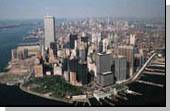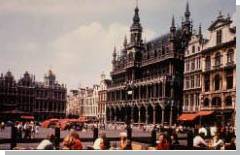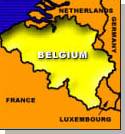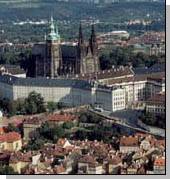|
 They
boarded the plane in New York
City with high hopes. The 18 members of the United
States figure skating
team would fly to Brussels,
Belgium. Then they
were to go on to Prague,
Czechoslovakia, for the world ice skating championships. A
photo was taken of the team members as they stood on the steps
of the Sabena Airlines 707 jet. The best of America’s skaters
beamed for the camera. Mostly young, they laughed and giggled,
their eyes dancing with excitement. This was going to be the
time of their lives. They
boarded the plane in New York
City with high hopes. The 18 members of the United
States figure skating
team would fly to Brussels,
Belgium. Then they
were to go on to Prague,
Czechoslovakia, for the world ice skating championships. A
photo was taken of the team members as they stood on the steps
of the Sabena Airlines 707 jet. The best of America’s skaters
beamed for the camera. Mostly young, they laughed and giggled,
their eyes dancing with excitement. This was going to be the
time of their lives. 
 There
were three ice skating pairs on the plane. Two were brother-and-sister
teams: Laurie and William Hickox and Ida and Ray Hadley. There
was also the husband-and-wife team of Patricia and Robert
Dineen. But the brightest star of all was a singles skater.
Her name was Laurence “Laurie” Owen. Only 16 years old, she
had won the North American title for women just two days earlier.
Laurie had great skill, dazzling grace, and a winning smile. There
were three ice skating pairs on the plane. Two were brother-and-sister
teams: Laurie and William Hickox and Ida and Ray Hadley. There
was also the husband-and-wife team of Patricia and Robert
Dineen. But the brightest star of all was a singles skater.
Her name was Laurence “Laurie” Owen. Only 16 years old, she
had won the North American title for women just two days earlier.
Laurie had great skill, dazzling grace, and a winning smile.

 Laurie
came from a skating family. Her mother, Maribel, had won the
U.S figure skating championship nine times. Laurie had an
older sister who shared her mother’s name. Maribel Owen, age
20, was not quite as strong a skater as Laurie. Still, she
had just won the U.S. senior pairs championship. All three
of the Owen women were on the plane bound for Brussels. Laurie
came from a skating family. Her mother, Maribel, had won the
U.S figure skating championship nine times. Laurie had an
older sister who shared her mother’s name. Maribel Owen, age
20, was not quite as strong a skater as Laurie. Still, she
had just won the U.S. senior pairs championship. All three
of the Owen women were on the plane bound for Brussels. 
 Sabena
Flight 548 took off at 7:30 P.M. on February 14, 1961. The
flight across the Atlantic was pleasant. Early the next day,
the plane neared the airport at Brussels. There seemed to
be no cause for concern. There was no distress signal of any
kind from the pilot, Captain Louis Lambrechts. There were
no storms or high winds in the region. In fact, the weather
was perfect. It was warm and sunny. Sabena
Flight 548 took off at 7:30 P.M. on February 14, 1961. The
flight across the Atlantic was pleasant. Early the next day,
the plane neared the airport at Brussels. There seemed to
be no cause for concern. There was no distress signal of any
kind from the pilot, Captain Louis Lambrechts. There were
no storms or high winds in the region. In fact, the weather
was perfect. It was warm and sunny. 
 But
something must have gone wrong in the cockpit.
During the last few minutes before the scheduled landing,
Captain Lambrechts did not contact the Brussels airport. Just
before 10:00 A.M., he lowered the wheels of the jet and began
his approach to land. But, at the last moment, he pulled the
plane up. Perhaps he saw another jet taking off and feared
a collision. Or perhaps he already knew that something was
wrong with his plane. In any case, he circled the airport
and prepared to try again. But
something must have gone wrong in the cockpit.
During the last few minutes before the scheduled landing,
Captain Lambrechts did not contact the Brussels airport. Just
before 10:00 A.M., he lowered the wheels of the jet and began
his approach to land. But, at the last moment, he pulled the
plane up. Perhaps he saw another jet taking off and feared
a collision. Or perhaps he already knew that something was
wrong with his plane. In any case, he circled the airport
and prepared to try again. 
 Lambrechts
came in a second time, flying about 500 feet over a farm near
the village of Berg, northeast of Brussels. Then he suddenly
increased his speed and pulled the plane into a steep climb.
By this time, officials in the Brussels control tower could
tell that something was very wrong. “We saw the crash coming,”
said one official. “They couldn’t have been faster,” the official
said. “But there was nothing they could do.” Lambrechts
came in a second time, flying about 500 feet over a farm near
the village of Berg, northeast of Brussels. Then he suddenly
increased his speed and pulled the plane into a steep climb.
By this time, officials in the Brussels control tower could
tell that something was very wrong. “We saw the crash coming,”
said one official. “They couldn’t have been faster,” the official
said. “But there was nothing they could do.” 
 A
man riding on a train saw that the plane was in trouble. “The
plane appeared to be making a normal approach to land when
it suddenly reared up into the sky,” he said. “Then it fell
back like a great stone and we heard the explosion.” A
man riding on a train saw that the plane was in trouble. “The
plane appeared to be making a normal approach to land when
it suddenly reared up into the sky,” he said. “Then it fell
back like a great stone and we heard the explosion.” 
 It
was 10:05 A.M. when the Sabena jet hit the ground and exploded
in a ball of flames. It just missed hitting a row of houses.
All 72 people on board were killed, including 49 Americans
and 11 members of the crew. There was nothing anyone could
do. The crash site was a scene of total destruction. Debris
was scattered over 200 yards. Charred
remains and body parts were strewn
all over the area. Several couples on the plane were found
locked in a final embrace. It
was 10:05 A.M. when the Sabena jet hit the ground and exploded
in a ball of flames. It just missed hitting a row of houses.
All 72 people on board were killed, including 49 Americans
and 11 members of the crew. There was nothing anyone could
do. The crash site was a scene of total destruction. Debris
was scattered over 200 yards. Charred
remains and body parts were strewn
all over the area. Several couples on the plane were found
locked in a final embrace. 
 The
crash stunned
skaters and figure skating fans around the globe. Never before
had anything so tragic
happened in their sport. To honor the dead, the Prague competition
was canceled. The crash was particularly devastating
for some families. In addition to the Owen family, with its
loss of three women, nine other skating families suffered
more than one death. The hopes and dreams of these athletes
had ended in a flash. All that remained as rescuers combed
through the wreckage
were three pairs of melted skates dangling from one of the
wings. The
crash stunned
skaters and figure skating fans around the globe. Never before
had anything so tragic
happened in their sport. To honor the dead, the Prague competition
was canceled. The crash was particularly devastating
for some families. In addition to the Owen family, with its
loss of three women, nine other skating families suffered
more than one death. The hopes and dreams of these athletes
had ended in a flash. All that remained as rescuers combed
through the wreckage
were three pairs of melted skates dangling from one of the
wings. 
↑TOP
(688
words)
|
 New York City is the largest city in the United States, the home of the
United Nations, and the center of global finance, communications, and
business.
New York City is the largest city in the United States, the home of the
United Nations, and the center of global finance, communications, and
business. 

 Prague is the capital and largest city of the Czech Republic, located
in the west central part of the country. Often called the City of a Hundred
Spires because of its many churches and towers, Prague is the chief commercial,
industrial, and cultural center of the Czech Republic.
Prague is the capital and largest city of the Czech Republic, located
in the west central part of the country. Often called the City of a Hundred
Spires because of its many churches and towers, Prague is the chief commercial,
industrial, and cultural center of the Czech Republic.